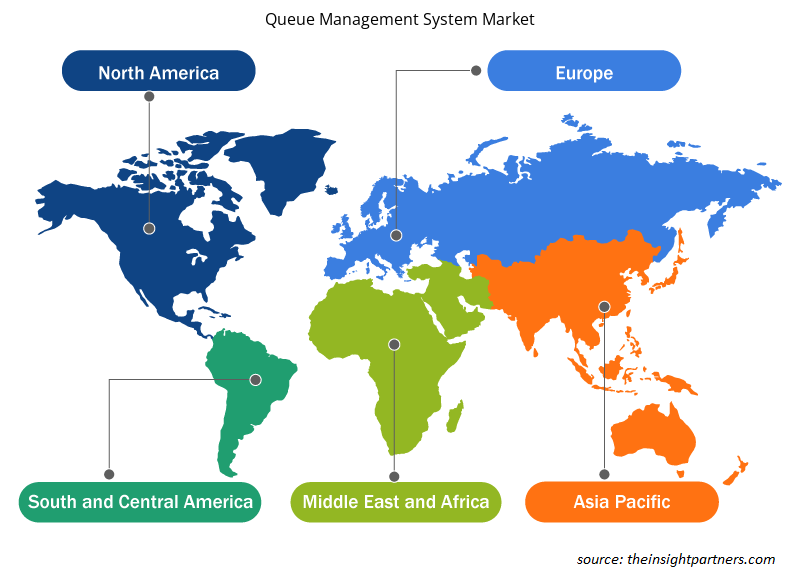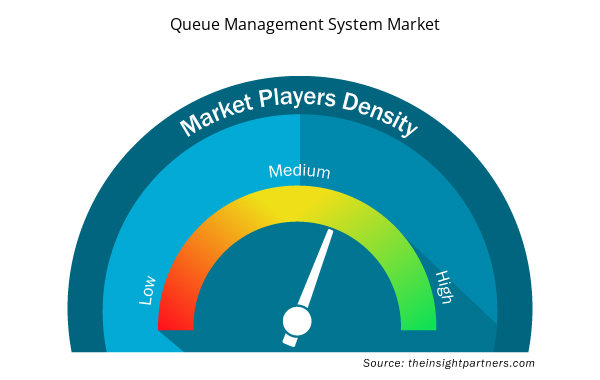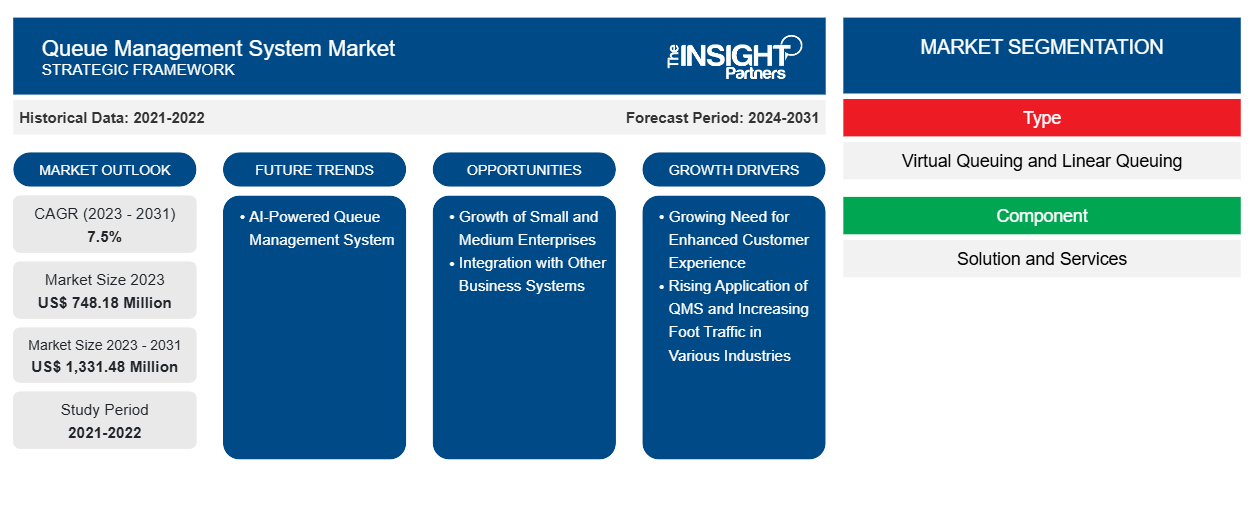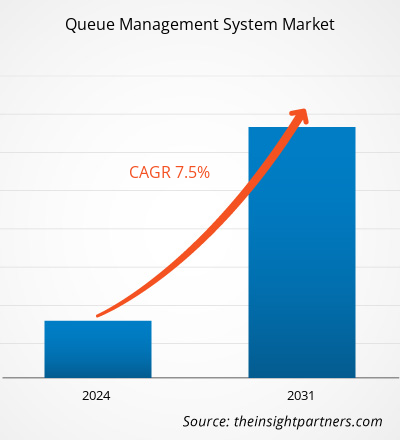キュー管理システムの市場規模は、2023年の7億4,818万米ドルから2031年には13億3,148万米ドルに達すると予想されています。市場は2023年から2031年の間に7.5%のCAGRを記録すると予測されています。AIを活用したキュー管理システムの需要の高まりは、今後数年間で市場に新たなトレンドをもたらす可能性があります。
キュー管理システム市場分析
顧客体験の向上の必要性、QMSの適用の増加、さまざまな業界での来店客数の増加などの要因が、キュー管理システム市場を牽引しています。中小企業(SME)の成長、仮想キュー管理の需要の増加、QMSと他のビジネスシステムの統合により、市場は予測期間中に成長すると予想されます。AIを活用したキュー管理システムの増加は、市場の主要なトレンドです。さらに、クラウドベースのテクノロジーの増加と、仮想キューイングやモバイルチケットなどの高度なソリューションの採用により、組織と顧客とのやり取りの方法が変わり、柔軟性と効率性が向上しました。ヘルスケア、小売、銀行の各セクターは、増加する顧客数に対応し、運用効率を向上させるためにQMSを実装するケースが増えており、この成長に大きく貢献しています。さらに、これらのシステム内でのデータ分析の統合により、組織がサービスプロセスを最適化し、最終的に製品の採用と市場の拡大を促進するのに役立つ貴重な洞察が得られます。
キュー管理システム市場の概要
キュー管理システム(QMS)は、キュー内の顧客または訪問者の流れを管理および分析するために使用されるツールで構成されています。このシステムは、エンドユーザーの待ち時間を短縮することで運用効率を最適化することを目的としています。キュー管理システムは、サービスプロバイダーがサービスの提供を強化し、従業員の生産性を高め、キューイングエクスペリエンスを合理化するのに役立ちます。キュー管理システム市場は、キューを効率的かつ便利に構築および管理する需要の高まりにより、長年にわたって着実に成長しています。長年にわたり、キュー管理システムのエンドユーザーの数は急増し続けています。このシステムは、小売店、BFSI、ヘルスケア、政府機関、教育機関のニーズに合わせてカスタマイズされています。たとえば、国際空港評議会(ACI)ワールドによると、2022年から2040年までの乗客トラフィックは年間平均5.8%増加し、2040年まで毎年190億人を超える乗客が空港を利用することになります。これにより、予測期間中に空港でのキュー管理システムの採用が増加すると予想されます。
要件に合わせてレポートをカスタマイズする
このレポートの一部、国レベルの分析、Excelデータパックなど、あらゆるレポートを無料でカスタマイズできます。また、スタートアップや大学向けのお得なオファーや割引もご利用いただけます。
- このレポートの主要な市場動向を入手してください。この無料サンプルには、市場動向から見積もりや予測に至るまでのデータ分析が含まれます。
キュー管理システム市場の推進要因と機会
顧客体験の向上に対するニーズの高まり
企業は、顧客の流れを管理し、待ち時間を短縮することで顧客満足度を大幅に高められることをますます認識しています。商品の返品、修理の依頼、質問への対応など、それぞれのやり取りは、顧客と企業との差し迫った関係を形成する上で重要な役割を果たします。Qtrac によると、93% の消費者は、企業が優れた顧客サービスを提供している場合、リピーターになる可能性が高いと回答しています。さらに、Zendesk によると、73% の消費者は、企業とのネガティブな体験が何度かあった後、競合他社に乗り換える可能性が高いと回答しています。この統計は、高品質の顧客サービスと一貫したポジティブなやり取りを維持することの重要性を強調しています。競争が激しい市場シナリオでは、消費者に多数の選択肢があるため、企業は顧客体験が顧客維持に与える影響を見逃してはなりません。乗り換えの決定は、多くの場合、即時の体験だけでなく、過去のやり取りの累積的な影響も考慮する必要があります。顧客を失うリスクを軽減するには、組織は潜在的な問題に積極的に対処し、顧客からのフィードバックを求め、そのフィードバックに基づいて改善を実施する必要があります。優れたサービスを優先し、顧客満足への取り組みを示すことで、企業は顧客の忠誠心を育み、顧客が競合他社に流れてしまう可能性を減らすことができます。顧客体験を優先するこの方向への変化により、組織はキュー管理ソリューションを採用するようになっています。
人口の急増は、病院、小売店、診療所、空港などの施設で整理されていない行列を引き起こす主な要因であり、群衆の間でフラストレーションを引き起こし、サービスの質を低下させます。さらに、営業時間のピーク時には、行列の混雑が続き、スタッフが手動で行列を管理しようとするため、サービスの質が低下します。 2022年1月のミッドランドテクニカルカレッジのデータによると、企業はサービスの質の悪さと顧客の不満のために潜在的な顧客を失っています。データによると、顧客サービスの質の悪さは、長い行列、コスト削減戦略、顧客の要望の理解不足、成長のために顧客満足度を犠牲にすることなどにより、年間750億米ドルから1.6兆米ドルのビジネス損失を引き起こしています。この収益の損失は今後数年間で増加すると予測されており、顧客の好みが競合他社の製品に移行し、潜在的な顧客を失うことになります。キューを効率的に管理し、サービス品質を向上させる目的で、各サービス プロバイダーはキュー管理ソリューションを選択します。したがって、顧客エクスペリエンスの向上に対するニーズの高まりが、キュー管理システム市場を牽引しています。
中小企業の成長
中小企業(SME)の成長は、予測期間中にキュー管理システム市場の拡大に大きな機会をもたらすと予想されます。中小企業は多くの場合、その俊敏性と適応性が特徴であり、大企業よりも効果的に特定の顧客ニーズを満たすカスタマイズされたソリューションを開発することができます。2022年には、欧州連合の全企業の約99%を占める中小企業は、より機敏で革新的であることが多く、QMSなどの高度なテクノロジーを採用して顧客体験と運用効率を向上させることができます。さらに、2021年には、経済協力開発機構(OECD)によると、中小企業は多くの国の経済状況で重要な役割を果たしており、総雇用の約50%と国内総生産(GDP)の40%を占めています。中小企業が成長を続け、競争上の優位性を求めるにつれて、これらの企業が運用効率と顧客体験の向上の重要性を認識するため、キュー管理システム(QMS)の採用が増加するでしょう。中小企業が拡大するにつれ、迅速で効率的なサービスに対する顧客の期待が高まり、顧客フローを効果的に管理することが不可欠になっています。キュー管理システムは、これらの企業に、業務を合理化し、待ち時間を短縮し、全体的なサービス提供を改善するためのツールを提供します。これは、競争の激しい市場で顧客を維持するために不可欠です。さらに、中小企業ではデジタルソリューションの統合がますます普及しており、リアルタイムのデータ分析を利用してサービスプロセスを最適化する高度なQMSの実装が可能になっています。この傾向により、顧客満足度が向上するだけでなく、中小企業の生産性と運用効率が向上し、最終的には市場での持続可能性が促進されます。
キュー管理システム市場レポートのセグメンテーション分析
キュー管理システム市場分析の導出に貢献した主要なセグメントは、タイプ、コンポーネント、およびアプリケーションです。
- タイプに基づいて、キュー管理システム市場は仮想キューイングとリニアキューイングに分かれています。2023年には仮想キューイングセグメントが市場を支配しました。
- コンポーネントに基づいて、キュー管理システム市場はソリューションとサービスに分かれています。ソリューションセグメントは2023年に市場でより大きなシェアを占めました。
- アプリケーションの観点から見ると、キュー管理システム市場は、BFSI、病院、小売店、レストラン、ユーティリティサービスプロバイダーと空港、政府機関などに分類されます。小売店セグメントは、2023年に市場を支配しました。
地域別のキュー管理システム市場シェア分析
- キュー管理システム市場は、北米、ヨーロッパ、アジア太平洋 (APAC)、中東およびアフリカ (MEA)、南米および中米の 5 つの主要地域に分割されています。2023 年には北米が市場を支配し、ヨーロッパと APAC がそれに続きました。
- 北米がキュー管理システム市場を支配し、ヨーロッパとアジア太平洋がそれに続きました。北米での市場の優位性は、主に多数のエンドユーザー産業の存在に関係しています。北米でのキュー管理システム市場の発展は、ヘルスケア、航空、小売業界での使用の増加によって推進されています。先進技術を採用するためのヘルスケア業界への投資は、地域全体で急速に増加しています。 JAHANI AND ASSOCIATES LLCによると、2022年、米国のヘルスケア部門はCOVID-19パンデミックの影響により資本市場活動の増加を観察しました。ヘルスケア業界は、ヘルスケアサービスを改善するための技術開発のために1,100億米ドルの投資を受けました。さらに、ヘルスケア業界の取引の約45%は、企業が既存の技術を開発するために行った合併と買収(M&A)取引でした。病院を訪れる患者数の増加によるヘルスケア業界の拡大は、地域全体の市場成長を促進しています。さらに、北米にはキュー管理システムのハードウェア製造業者とソフトウェア開発業者が集中しており、エンドユーザーはさまざまなプロバイダーからシステムを調達できます。さらに、カナダとメキシコのキュー管理システム市場も、システムプロバイダーとエンドユーザーの数が絶えず増加しているため、急速に人気を集めています。このように、調達率の上昇が北米のキュー管理システム市場を推進しています。
キュー管理システム市場の地域別分析
予測期間を通じてキュー管理システム市場に影響を与える地域的な傾向と要因は、Insight Partners のアナリストによって徹底的に説明されています。このセクションでは、北米、ヨーロッパ、アジア太平洋、中東およびアフリカ、南米および中米にわたるキュー管理システム市場のセグメントと地理についても説明します。

- キュー管理システム市場の地域別データを入手
キュー管理システム市場レポートの範囲
| レポート属性 | 詳細 |
|---|---|
| 2023年の市場規模 | 7億4,818万米ドル |
| 2031年までの市場規模 | 13億3,148万米ドル |
| 世界のCAGR(2023年~2031年) | 7.5% |
| 履歴データ | 2021-2022 |
| 予測期間 | 2024-2031 |
| 対象セグメント | タイプ別
|
| 対象地域と国 | 北米
|
| 市場リーダーと主要企業プロフィール |
|
市場プレーヤーの密度:ビジネスダイナミクスへの影響を理解する
キュー管理システム市場は、消費者の嗜好の変化、技術の進歩、製品の利点に対する認識の高まりなどの要因により、エンドユーザーの需要が高まり、急速に成長しています。需要が高まるにつれて、企業は提供内容を拡大し、消費者のニーズを満たすために革新し、新たなトレンドを活用し、市場の成長をさらに促進しています。
市場プレーヤー密度とは、特定の市場または業界内で活動している企業または会社の分布を指します。これは、特定の市場スペースに、その市場規模または総市場価値に対してどれだけの競合相手 (市場プレーヤー) が存在するかを示します。
キュー管理システム市場で事業を展開している主要企業は次のとおりです。
- Q-MATICグループAB
- クミンダー株式会社
- キューノミー株式会社
- スキップリノ
- ウェーブテック
- オーリオンプロソリューションズ株式会社
免責事項:上記の企業は、特定の順序でランク付けされていません。

- キュー管理システム市場のトップキープレーヤーの概要を入手
キュー管理システム市場のニュースと最近の動向
キュー管理システム市場は、主要な企業出版物、協会データ、データベースを含む一次調査と二次調査後の定性的および定量的データを収集することによって評価されます。キュー管理システム市場におけるいくつかの開発を以下に示します。
- アドバンテックは、POSおよびKIOSKブランドで有名なフランス企業、Aures Technologies SAの買収を発表しました。この戦略的な動きは、スマートリテール製品およびサービスにおけるアドバンテックのグローバルなカバレッジを強化し、世界有数のスマートリテールソリューションプロバイダーとしての地位を向上させることを目的としています。(出典: アドバンテック、プレスリリース、2024年4月)
- Wavetec は、パンジャブ銀行との提携拡大を発表しました。同銀行は、支店全体に 300 台ものキュー管理システム (QMS) を導入しました。(出典: Wavetec、プレスリリース、2024 年 6 月)
キュー管理システム市場レポートの対象範囲と成果物
「キュー管理システム市場規模と予測(2021〜2031年)」では、以下の分野をカバーする市場の詳細な分析を提供しています。
- キュー管理システムの市場規模と予測は、スコープに含まれるすべての主要な市場セグメントについて、世界、地域、国レベルで示されています。
- キュー管理システム市場の動向、および推進要因、制約、主要な機会などの市場動向
- 詳細なPESTおよびSWOT分析
- 主要な市場動向、世界および地域の枠組み、主要プレーヤー、規制、最近の市場動向を網羅したキュー管理システム市場分析
- 市場集中、ヒートマップ分析、主要プレーヤー、キュー管理システム市場の最近の動向を網羅した業界展望と競争分析
- 詳細な企業プロフィール
- 過去2年間の分析、基準年、CAGRによる予測(7年間)
- PEST分析とSWOT分析
- 市場規模価値/数量 - 世界、地域、国
- 業界と競争環境
- Excel データセット


- Vertical Farming Crops Market
- High Speed Cable Market
- Electronic Shelf Label Market
- Small Molecule Drug Discovery Market
- Hydrogen Compressors Market
- Hydrolyzed Collagen Market
- Fishing Equipment Market
- Genetic Testing Services Market
- Automotive Fabric Market
- Emergency Department Information System (EDIS) Market

Report Coverage
Revenue forecast, Company Analysis, Industry landscape, Growth factors, and Trends

Segment Covered
This text is related
to segments covered.

Regional Scope
North America, Europe, Asia Pacific, Middle East & Africa, South & Central America

Country Scope
This text is related
to country scope.
よくある質問
The queue management system market was valued at US$ 748.18 million in the year 2023 and is expected to grow at a CAGR of 7.5% during 2023-2031.
The growing need for enhanced customer experience and the rising application of QMS and increasing foot traffic in various industries are the driving factors impacting the queue management system market.
The key players holding majority shares in the queue management system market include Advantech Co Ltd, Wavetec, Lavi Industries, Q-MATIC Group AB, and Aurionpro Solutions Ltd.
The virtual queuing segment led the queue management system market with a significant share in 2023 and is also expected to grow with the highest CAGR.
Asia Pacific is anticipated to grow with the highest CAGR over the forecast period.
AI-powered queue management system is the future trend of the queue management system market.
The queue management system market is expected to reach US$ 1,331.48 by 2031.
North America held the largest market share in 2023, followed by Europe and Asia Pacific.
Trends and growth analysis reports related to Technology, Media and Telecommunications : READ MORE..
The List of Companies - Queue Management System Market
- Q-MATIC Group AB
- Qminder Ltd
- Q-nomy Inc
- Skiplino
- Wavetec
- Aurionpro Solutions Ltd
- Advantech Co Ltd
- SEDCO Co Ltd
- Lavi Industries
- AKIS Technologies UAB
- WaitWell
- Verint Systems Inc
- QLESS
- OFFTEC Holding Group
- Waitwhile, Inc
The Insight Partners performs research in 4 major stages: Data Collection & Secondary Research, Primary Research, Data Analysis and Data Triangulation & Final Review.
- Data Collection and Secondary Research:
As a market research and consulting firm operating from a decade, we have published and advised several client across the globe. First step for any study will start with an assessment of currently available data and insights from existing reports. Further, historical and current market information is collected from Investor Presentations, Annual Reports, SEC Filings, etc., and other information related to company’s performance and market positioning are gathered from Paid Databases (Factiva, Hoovers, and Reuters) and various other publications available in public domain.
Several associations trade associates, technical forums, institutes, societies and organization are accessed to gain technical as well as market related insights through their publications such as research papers, blogs and press releases related to the studies are referred to get cues about the market. Further, white papers, journals, magazines, and other news articles published in last 3 years are scrutinized and analyzed to understand the current market trends.
- Primary Research:
The primarily interview analysis comprise of data obtained from industry participants interview and answers to survey questions gathered by in-house primary team.
For primary research, interviews are conducted with industry experts/CEOs/Marketing Managers/VPs/Subject Matter Experts from both demand and supply side to get a 360-degree view of the market. The primary team conducts several interviews based on the complexity of the markets to understand the various market trends and dynamics which makes research more credible and precise.
A typical research interview fulfils the following functions:
- Provides first-hand information on the market size, market trends, growth trends, competitive landscape, and outlook
- Validates and strengthens in-house secondary research findings
- Develops the analysis team’s expertise and market understanding
Primary research involves email interactions and telephone interviews for each market, category, segment, and sub-segment across geographies. The participants who typically take part in such a process include, but are not limited to:
- Industry participants: VPs, business development managers, market intelligence managers and national sales managers
- Outside experts: Valuation experts, research analysts and key opinion leaders specializing in the electronics and semiconductor industry.
Below is the breakup of our primary respondents by company, designation, and region:

Once we receive the confirmation from primary research sources or primary respondents, we finalize the base year market estimation and forecast the data as per the macroeconomic and microeconomic factors assessed during data collection.
- Data Analysis:
Once data is validated through both secondary as well as primary respondents, we finalize the market estimations by hypothesis formulation and factor analysis at regional and country level.
- Macro-Economic Factor Analysis:
We analyse macroeconomic indicators such the gross domestic product (GDP), increase in the demand for goods and services across industries, technological advancement, regional economic growth, governmental policies, the influence of COVID-19, PEST analysis, and other aspects. This analysis aids in setting benchmarks for various nations/regions and approximating market splits. Additionally, the general trend of the aforementioned components aid in determining the market's development possibilities.
- Country Level Data:
Various factors that are especially aligned to the country are taken into account to determine the market size for a certain area and country, including the presence of vendors, such as headquarters and offices, the country's GDP, demand patterns, and industry growth. To comprehend the market dynamics for the nation, a number of growth variables, inhibitors, application areas, and current market trends are researched. The aforementioned elements aid in determining the country's overall market's growth potential.
- Company Profile:
The “Table of Contents” is formulated by listing and analyzing more than 25 - 30 companies operating in the market ecosystem across geographies. However, we profile only 10 companies as a standard practice in our syndicate reports. These 10 companies comprise leading, emerging, and regional players. Nonetheless, our analysis is not restricted to the 10 listed companies, we also analyze other companies present in the market to develop a holistic view and understand the prevailing trends. The “Company Profiles” section in the report covers key facts, business description, products & services, financial information, SWOT analysis, and key developments. The financial information presented is extracted from the annual reports and official documents of the publicly listed companies. Upon collecting the information for the sections of respective companies, we verify them via various primary sources and then compile the data in respective company profiles. The company level information helps us in deriving the base number as well as in forecasting the market size.
- Developing Base Number:
Aggregation of sales statistics (2020-2022) and macro-economic factor, and other secondary and primary research insights are utilized to arrive at base number and related market shares for 2022. The data gaps are identified in this step and relevant market data is analyzed, collected from paid primary interviews or databases. On finalizing the base year market size, forecasts are developed on the basis of macro-economic, industry and market growth factors and company level analysis.
- Data Triangulation and Final Review:
The market findings and base year market size calculations are validated from supply as well as demand side. Demand side validations are based on macro-economic factor analysis and benchmarks for respective regions and countries. In case of supply side validations, revenues of major companies are estimated (in case not available) based on industry benchmark, approximate number of employees, product portfolio, and primary interviews revenues are gathered. Further revenue from target product/service segment is assessed to avoid overshooting of market statistics. In case of heavy deviations between supply and demand side values, all thes steps are repeated to achieve synchronization.
We follow an iterative model, wherein we share our research findings with Subject Matter Experts (SME’s) and Key Opinion Leaders (KOLs) until consensus view of the market is not formulated – this model negates any drastic deviation in the opinions of experts. Only validated and universally acceptable research findings are quoted in our reports.
We have important check points that we use to validate our research findings – which we call – data triangulation, where we validate the information, we generate from secondary sources with primary interviews and then we re-validate with our internal data bases and Subject matter experts. This comprehensive model enables us to deliver high quality, reliable data in shortest possible time.


 このレポートの無料サンプルを入手する
このレポートの無料サンプルを入手する